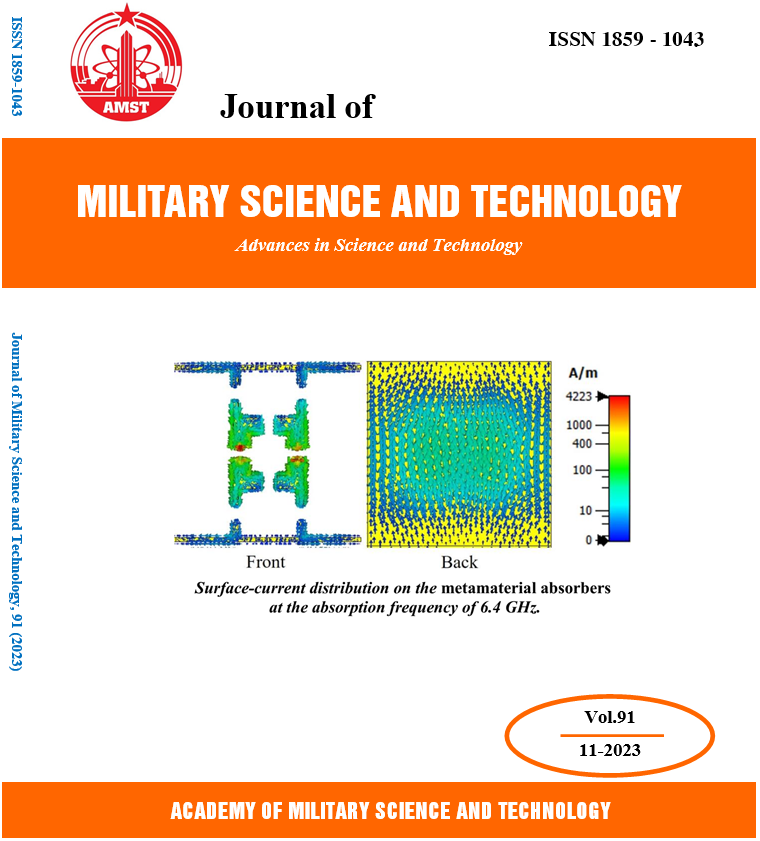Phát triển thuật toán điều khiển công suất truyền dữ liệu đường xuống cho mạng vô tuyến quanh cơ thể hợp tác
418 lượt xemDOI:
https://doi.org/10.54939/1859-1043.j.mst.91.2023.11-19Từ khóa:
Mạng vô tuyến quanh cơ thể; Truyền dữ liệu đường xuống; Điều khiển công suất truyền dữ liệu; Ước lượng kênh.Tóm tắt
Mạng vô tuyến quanh cơ thể (WBANs - Wireless Body Area Networks) hiện nay đang thu hút sự quan tâm và nghiên cứu của các nhà khoa học với rất nhiều ứng dụng tiềm năng trong lĩnh vực quân sự, y tế, cứu hộ cứu nạn, thể thao, giải trí và đặc biệt là trong theo dõi, chăm sóc sức khỏe từ xa. Trong bài báo này, các tác giả đề xuất một mô hình WBANs mới, gọi là ‘WBANs hợp tác’, với điểm khác biệt so với mô hình truyền thống là các cảm biến truyền và nhận dữ liệu trực tiếp từ các điểm truy cập (AP - Access Point) mà không thông qua bộ điều phối. Các tác giả cũng phát triển thuật toán điều khiển công suất truyền dữ liệu đường xuống từ AP đến cảm biến. Kết quả mô phỏng cho thấy rằng, khi áp dụng điều khiển công suất truyền dữ liệu, cảm biến đạt được thông lượng cao hơn so với trường hợp không điều khiển công suất, từ đó cải thiện chất lượng hệ thống.
Tài liệu tham khảo
[1]. H. Tataria, M. Shafi, A. F. Molisch, M. Dohler, H. Sjoland, and F. Tufvesson, “6g wireless systems: Vision, requirements, challenges, insights, and opportunities,” Proceedings of the IEEE, vol. 109, no. 7, pp. 1166–1199, (2021). DOI: https://doi.org/10.1109/JPROC.2021.3061701
[2]. G. Interdonato, “Cell-free massive mimo: Scalability, signal processingand power control,” Linkoping University Electronic Press, vol. 2090, (2020). DOI: https://doi.org/10.3384/diss.diva-167218
[3]. U. Hariharan, K. Rajkumar, and A. Ponmalar, “WBAN for e-healthcare application: Systematic review, challenges, and counter measures,” in 2021 International Conference on Computer Communication and Informatics (ICCCI). IEEE, (2021). DOI: https://doi.org/10.1109/ICCCI50826.2021.9402276
[4]. I. Pandey, H. S. Dutta, and J. S. Banerjee, “WBAN: A smart approach to next generation e-healthcare system,” in 2019 3rd International Conference on Computing Methodologies and Communication (ICCMC). IEEE, (2019). DOI: https://doi.org/10.1109/ICCMC.2019.8819713
[5]. D. S. Bhatti, S. Saleem, A. Imran, Z. Iqbal, A. Alzahrani, H. Kim, and K.-I. Kim, “A survey on wireless wearable body area networks: A perspective of technology and economy,” Sensors, vol. 22, no. 20, p. 7722, (2022). DOI: https://doi.org/10.3390/s22207722
[6]. B. T. Anh, D. T. Quan, and P. T. Hiep, “Developing the max-min power control algorithm for distributed wireless body area networks,” AEU - International Journal of Electronics and Communications, p. 154448, vol 158, (2023).
[7]. P. T. Hiep and R. Kohno, “Control superframe for high throughput of cluster-based WBAN with CSMA/CA,” in 2014 IEEE 25th Annual International Symposium on Personal, Indoor, and Mobile Radio Communication (PIMRC). IEEE, (2014). DOI: https://doi.org/10.1109/PIMRC.2014.7136336
[8]. M. Ali, H. Moungla, M. Younis, and A. Mehaoua, “Distributed scheme for interference mitigation of WBANs using predictable channel hopping,” in 2016 IEEE 18th International Conference on e-Health Networking, Applications and Services (Healthcom). IEEE, (2016). DOI: https://doi.org/10.1109/HealthCom.2016.7749506
[9]. B. Alte and A. Vidhate, “MAC protocol selection and performance analysis in wireless body area networks,” in 2022 IEEE 2nd Mysore Sub Section International Conference (MysuruCon). IEEE, (2022). DOI: https://doi.org/10.1109/MysuruCon55714.2022.9972349
[10]. P. T. Hiep, N. N. Thang, G. Sun, and N. H. Hoang, “Proposal of a hierarchical topology and spatial reuse superframe for enhancing throughput of a cluster-based WBAN,” ETRI Journal, vol. 41, no. 5, pp. 648–657, (2019). DOI: https://doi.org/10.4218/etrij.2018-0571
[11]. Y. Yang, D. Smith, J. Rajasegaran, and S. Seneviratne, “Power control for body area networks: Accurate channel prediction by lightweight deep learning,” IEEE Internet of Things Journal, vol. 8, no. 5, pp. 3567–3575, (2021). DOI: https://doi.org/10.1109/JIOT.2020.3024820
[12]. Z. Zhang, J. Huang, H. Wang, and H. Fang, “Power control and localization of wireless body area networks using semidefinite programming,” in 2015 2nd International Symposium on Future Information and Communication Technologies for Ubiquitous HealthCare (UbiHealthTech). IEEE, (2015). DOI: https://doi.org/10.1109/Ubi-HealthTech.2015.7203357
[13]. T. Wang and Y. Lu, “Advances, challenges and future trends of cell-free transcription- translation biosensors,” Biosensors, vol. 12, no. 5, p. 318, (2022). DOI: https://doi.org/10.3390/bios12050318
[14]. J. K. Jung, K. K. Alam, M. S. Verosloff, D. A. Capdevila, M. Desmau, P. R. Clauer, J. W. Lee, P. Q. Nguyen, P. A. Pasten, S. J. Matiasek, J.-F. Gaillard, D. P. Giedroc, J. J. Collins, and J. B. Lucks, “Cellfree biosensors for rapid detection of water contaminants,” Nature Biotechnology, vol. 38, no. 12, pp. 1451–1459, (2020). DOI: https://doi.org/10.1038/s41587-020-0571-7
[15]. A. M. Q. K. Al-Asadi, K. S. Muttair, A. G. Wadday, and M. F. Mosleh, “Wireless body-area network monitoring with ZigBee, 5g and 5g with MIMO for outdoor environments,” Bulletin of Electrical Engineering and Informatics, vol. 11, no. 2, pp. 893–900, (2022). DOI: https://doi.org/10.11591/eei.v11i2.3219
[16]. V. K. Jhunjhunwala, T. Ali, P. Kumar, P. Kumar, P. Kumar, S. Shrivastava, and A. A. Bhagwat, “Flexible UWB and MIMO antennas for wireless body area network: A review,” Sensors, vol. 22, no. 23, p. 9549, (2022). DOI: https://doi.org/10.3390/s22239549
[17]. Bui Tien Anh, Do Thanh Quan, Pham Thanh Hiep, “Developing the max-min power control algorithm for distributed wireless body area networks”, AEU - International Journal of Electronics and Communications, vol. 158, pp. 154448, (2023). DOI: https://doi.org/10.1016/j.aeue.2022.154448
[18]. H. Q. Ngo, A. Ashikhmin, H. Yang, E. G. Larsson, and T. L. Marzetta, “Cell-free massive MIMO versus small cells,” IEEE Transactions on Wireless Communications, vol. 16, no. 3, pp. 1834–1850, (2017). DOI: https://doi.org/10.1109/TWC.2017.2655515
[19]. M. B. Majed, T. A. Rahman, O. A. Aziz, M. N. Hindia, and E. Hanafi, “Channel characterization and path loss modeling in indoor environment at 4.5, 28, and 38 GHz for 5g cellular networks,” International Journal of Antennas and Propagation, vol. 2018, pp. 1–14, (2018). DOI: https://doi.org/10.1155/2018/9142367







